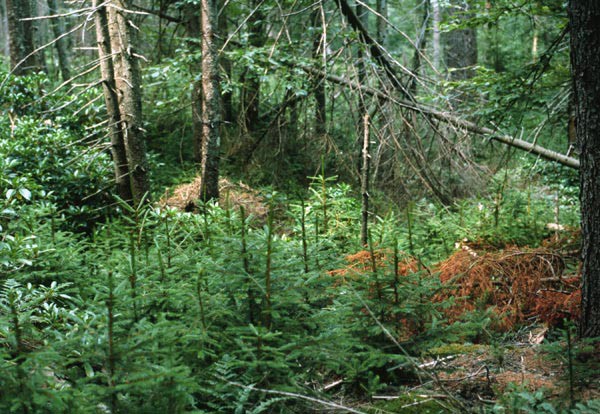A new study led by a researcher at the U.S. Geological Survey suggests that there are early indications that soils are recovering – at least in red spruce forests – from the detrimental effects of acid rain, although not all the news is good.
Acid rain, the result of pollutants in the emissions from power plants and other industrial facilities, has been a cause for concern for the forests of the Northeast for decades. Acidic deposition peaked in the 1970s, even before scientists recognized it was a problem. Little environmental data exist from the preacid-rain era against which to compare current conditions, making it difficult to determine whether the soils in the region have begun to recover.
“We’ve had 30 years of declining acidic deposition levels, but no one has been able to demonstrate that the soil has improved,” said Gregory Lawrence, the USGS research hydrologist who led the study. “We’ve seen improvement in surface waters since the 1990s, though not as much as expected. But the limited soil data we have from resampling sites from the early 1980s indicated that soils weren’t getting better and were in fact getting worse.”
So Lawrence tested soil samples in six red spruce stands in New York, Vermont, New Hampshire, and Maine, and compared them to samples from the same stands collected in 1992 and 1993. His results were published this year in the Soil Science Society of America Journal.
According to Lawrence, the two important indicators of soil health as it relates to acid deposition are calcium and aluminum. Calcium is the primary element that buffers the soil against the effects of acidity. The more calcium the better, and results showed that calcium levels have not improved in either the mineral soil or the organic layer, although calcium levels are no longer decreasing in the organic layer.
Naturally occurring aluminum in rocks is released by acid rain and converted to a toxic form in the soil, where it interferes with root function, and – when it leaches into water – can kill aquatic organisms.
The good news, he said, is that aluminum levels in the organic surface layer have declined 20 to 40 percent at all but one site. Unfortunately, he found no decline in aluminum in the mineral soil, and in some cases it may be increasing slightly.
“Vegetation processes seem to be taking control of things at the surface,” Lawrence explained. “Aluminum mobilization has decreased in the mineral soil as a result of lower acid rain levels, and this has led to decreased aluminum levels in the organic layer. But there just hasn’t been enough natural release of calcium from rocks to increase the availability of calcium in the soil.”
Lawrence focused on spruce forests because previous data were available from spruce stands for comparison. He speculates that stands of other tree species may not be faring as well.
“Some tree species with a high demand for calcium, like sugar maples, are still not doing well in some areas,” he said. “The soils under sugar maples are different – they don’t have as thick an organic layer – so they’ll be more dependent on the recovery of mineral soils.”


